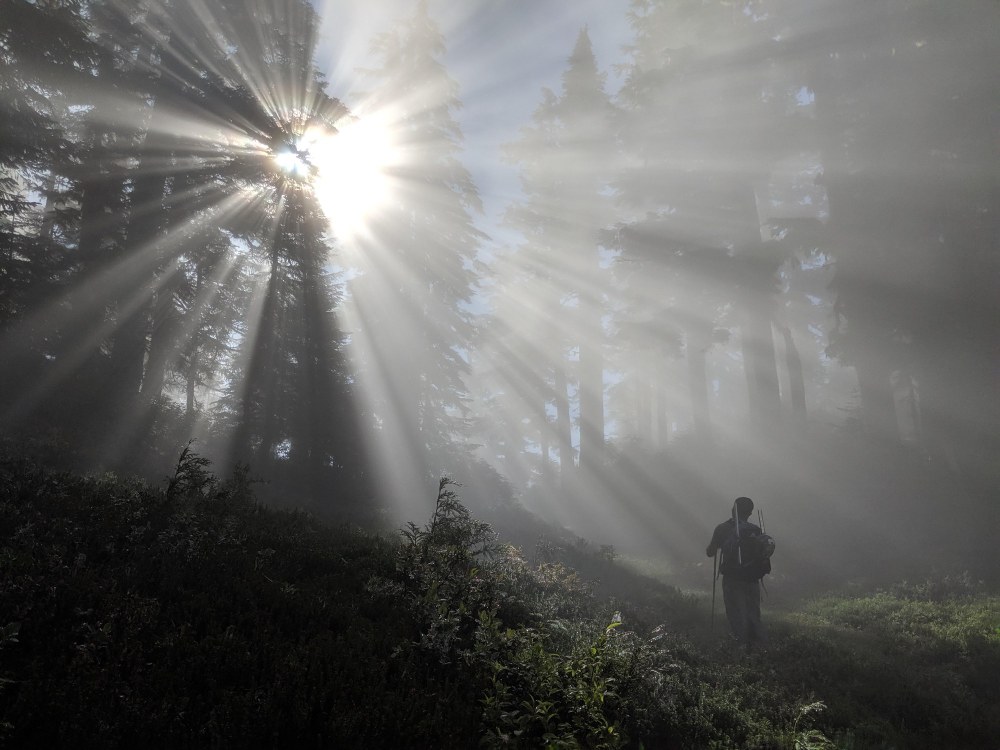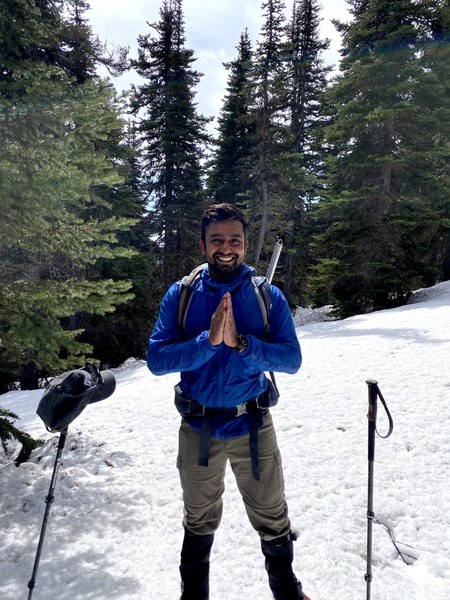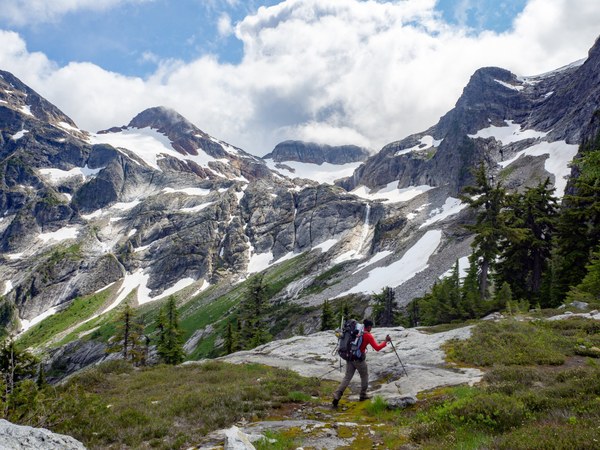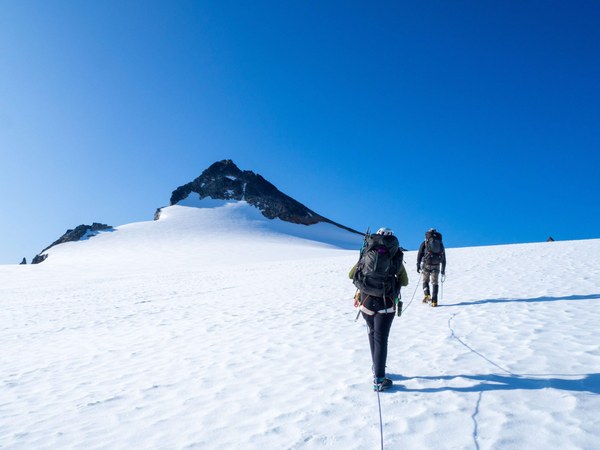
“Hiking is free. As long as you have shoes and an Orca card, you can go anywhere.”
Along with a smile and a full pack, this perspective carries Ananth Maniam (ஆனந்த் மணியம்) into the mountains. Known for his sarcastic wit and effusive personality, Ananth has made a name for himself in his three years at The Mountaineers. Recently named our Leader of the Year, he’s climbed eight peaks in a single day, spent a few nights at trailheads, and given hundreds of hours to our courses and committees, fitting a decade’s worth of northwest exploration into what feels like the blink of an eye. All while bagging almost 300 peaks along the way.
He scrambled, hiked, and climbed most of these miles with
ice cream in his pack, and almost all of them without a
personal car.
The Himalaya years
Born in Chennai, India, young Ananth spent his summers on
his grandparents’ farm in a remote village 200 miles from
the city. Days were spent working, collecting firewood, and
dreaming of exploring the mountains.
Although he was raised with a focus on academics, those
summers spent nestled in the Himalayan foothills allowed
his imagination to grow – thanks, in part, to a unique
relationship with his grandfather. “My granddad was the
biggest influence in my life. His name was Kandasamy. He
always encouraged me to follow my dreams and would
support me in anything I wanted to do, even if it was against
societal norms. As long as I believed in it, and as long as I
pursued it, my grandparents would support me. That’s how
it all started.”
 Vanakkam (வணக்கம்) - Hello. A typical greeting and smile for Ananth in the mountains.
Vanakkam (வணக்கம்) - Hello. A typical greeting and smile for Ananth in the mountains.
These dreams started to become a reality when
Ananth graduated from college and secured a job as a
mathematician, offering him the opportunity to fund
his first trip. Saving half of his monthly income for seven
months, he put 12,000 rupees (roughly 200 US dollars)
aside for a backpacking trip in Kashmir. This trip spawned
four more throughout the Himalayas, including two funded
by a backpacking outfit to thank Ananth for packing out
trash when he had traveled with them. In addition to guided
alpine trips, he also spent time living in the mountains to
better understand the environment and the locals.
“I went back to the mountains and stayed there for a few
months. Not just going with a guided group, but living with
people over there. And walking around the mountains,
getting a feel for how they are. I also don’t speak the
commonly spoken language Hindi – I only speak English
and Tamil. So when I traveled within India, language was
a problem for me (like every other person who travels the
world). But respect and love is something that you don’t
need language for, which aligned with how me and my
grandfather used to discuss travel. And having experience
in farming helped as well. They accepted me - I used to do
chores, help on local farms. I loved it, because in addition to
experiencing the mountains you also see how locals look at the mountains, how they protect the mountains, and how they worship the mountains.”
A northwest arrival
Fast forward six years, and Ananth has become a well-traveled
20-something with an itch for new adventures. He briefly lived in Luxembourg, traveling between Slovakia and Morocco for work, and was torn between Seattle and London as he searched for a new home. He first heard of Seattle on a backpacking trip in the Himalayas – a fellow traveler told him about the incredible mountains and an organization called The Mountaineers. That was enough to tip the scales, and Ananth found himself boarding a plane for SeaTac at 26.
However, The Mountaineers wasn’t his first stop when he
arrived. Ananth quickly joined a Meetup group called Seattle
Transit Hikers, both to combat the Seattle Freeze and
because he felt strongly about getting into the mountains
without a car. “In all my life, I’ve never owned a car. I’ve
always traveled with public transportation, even reaching
the most remote mountains in the Himalayas. So I’ve always
believed public transportation was the way to do it. Don’t let
something stop you – this is what my grandfather taught me.
If there is something blocking you, as long as you believe in
your methodology, do it. Even if it’s impossible.”
After a few trips with the transit hikers, Ananth once again
heard about The Mountaineers and decided to take the jump
into a membership. Though his friends wanted to take Basic
Climbing in Kitsap, he chose instead to take a scrambling
course with Seattle to keep his trips closer to home (and
ensure he wouldn’t need a car).
This transition was not without trepidation. Having felt
uncomfortable in the mountains in Europe where alpine
travel was typically reserved for the elite, Ananth was
unsure of how accepted he would feel in The Mountaineers.
“When I joined the organization I still had the persistent fear
I had in Europe – which is, will I be accepted? Will I have
barriers, in terms of language, in terms of race, in terms of how I deal with people? I had a lot of discussions with my
grandfather regarding how I would deal with all of these
things. And those were the last few conversations I had
with him – he passed away two or three months after I
moved to Seattle. Those words helped me progress within
the organization, and motivated me to be closer to the
organization, because the values of The Mountaineers
align with what me and my grandfather believed in.”
Creating community
After six months Ananth found himself drawn to volunteering.
Not only out of a desire to lead unpopular exploratory routes
(aka sufferfests), but to create community. Hoping to avoid
the competitiveness of climbing and skiing, Ananth dove into
volunteer roles in first aid, navigation, and scrambling. He’s
only missed a few first aid scenarios in the two years since.
Like many Super Volunteers, there is a reason beyond
passion for the outdoors that drives Ananth to dedicate
so much of himself to the organization. It’s the ability to
offer unique trips, cultivate friendships, and form lasting
community that keeps him coming back.
“My favorite trips are led like a family or friend outing, unlike
a guided group. Where leaders take several steps back at the
trailhead. This allows people to discuss things – they’re open,
they make friends, and they stay in contact. I also want to
encourage more volunteers to come in, and one way to do
that is to create a sense of family. Not just a sense of teaching
a course, but a sense of being part of a community.”
 Ananth on the approach to Colonia Basin on a three-day mountaineering trip.
Ananth on the approach to Colonia Basin on a three-day mountaineering trip.
Ananth has a knack for creating community. As a member
of five committees, instructor for three courses, and a twoyear
Super Volunteer, all of his emergency contacts are
now Mountaineers members (or their partners while they’re
off climbing with him). Perfecting his summit ice cream
has helped – with a painstakingly crafted five-step routine,
Ananth brings spare spoons and ice cream, gelato, or sorbet
on almost all his trips, so that even lactose-free climbers
can share in the delight.
This careful focus on small joys is a window into how Ananth
views the outdoors. It’s about slowing down and seeing what
you have - the purpose running deeper than sending hard or
telling tall tales over a drink.
“My goal is not to be a badass climber. I get outdoors so
that I don’t die of diabetes (I eat a lot of ice cream) and
to be with fun people, doing fun things. It doesn’t have to
be a 5.10 or 5.11 rock climb, it doesn’t have to be a black
diamond run. Just go out, be with people – if the people
are fun, then it’s good.”
Carpooling is mandatory
With hundreds of peaks under his belt and nearly all of them
without a personal vehicle, Ananth has established himself
as an impressive outdoorsman and stalwart advocate of
public transit and carpooling. He even requires carpooling
on all of the trips he leads, asking participants to park at
local gas stations before carpooling to the trailhead to avoid
flooding the lot with Mountaineers.
This commitment isn’t always easy. Delayed busses, long
transit rides, and nights spent on the side of the road have
dotted his path to and from the trail. Not to mention others’
reactions to a grubby hiker on the bus.
“What was it like getting outdoors without a car? It was tough as hell. Sometimes people thought I was a homeless person when I came back from a hike. I was a brown person with a beard who was sweaty, carrying a heavy backpack, and traveling on a bus. All these things create a mental model for someone. But hey – you gotta do what you gotta do.”
Since he moved to Seattle Trailhead Direct has become an
option for urban hikers, in part thanks to Ananth’s advocacy
work with Seattle Transit Hikers and City Council. Increasing
access to the outdoors means greater equity and more
diversity on the trails, an elemental factor of his values.
“One of the primary reasons I feel like The Mountaineers are my acquired family is because of how welcoming we
are to diversity. All races, genders, ethnicities, languages,
sizes, skill levels, and economic backgrounds. Diversity and
inclusivity is something close to my heart, and though I’ve
learned a lot at The Mountaineers, the ability to give back to
a diverse group of members means even more.”
Finding family
Ananth has found additional benefits to car-free travel as
well. Always the community builder, the small moments
traveling to a trailhead serve as the catalyst for something
more between him and his trip partners.
“I’ve done around 300 ascents over three years and three
months (I don’t have a life). Most if not all of these peaks
were without a car, which means that 99% of my trips are
with other people. It’s a big part of all of the family I’ve
made. Getting into someone’s car isn’t just carpooling,
they’re letting you inside something which is their own. I
find it criminal to sleep when someone else is driving. So I
always make sure I have a ton of bad jokes, a lot of sarcasm,
and stories to tell - that way we’re actually forming a bond
before the trip starts. That personal connection is pretty
rare these days, and I was really lucky to find that.”
Over the last three years, Ananth has built a community for
himself and fellow Mountaineers founded on acceptance
and finding joy in the outdoors. He’s advocated for public
transit solutions to increase outdoor access and fired up
a coalition of volunteers, all while growing his community
one car ride at time. This is no small feat for even the most
gregarious outdoorsman. These values have been the key
to a wealth of mountain summits and chosen family - that,
and an Orca card.
 Ananth leading a rope team to Snowfield Peak through Neve Glacier.
Ananth leading a rope team to Snowfield Peak through Neve Glacier.
THE SECRET TO SUMMIT ICE CREAM
Step 1: Get an insulated waterproof container (Ananth uses Snow Peak’s Kanpai bottle)
Step 2: Spray water into your empty container, freezing it for 1 hour
Step 3: Pack your ice cream in, filling it tightly without air pockets
Step 4: Leave the lid open and keep it in your freezer overnight
Step 5: Pop the lid on and put it in your pack the morning of your trip. Enjoy!
ANANTH’S TIPS TO EXPLORING
WITHOUT A CAR
- Don’t be afraid to walk from your bus stop to the trail head, even if it takes a few hours
- If you’re traveling with The Mountaineers, reach out early to leaders and participants to ask if you could carpool with one of them (and be sure to thank them!)
- Always carry cash to hand over to your driver if you’re carpooling
- Remember that traveling via public transit takes 2-4 times longer than it would with a car
- Look for transit options to Park and Rides – there are many that arrive before 7am
- When carpooling be courteous and make conversation – it’s a good opportunity to make friends
- Don’t forget to utilize urban trails, neighborhood walks, and local parks to get outside
MAIN IMAGE of the First break of sunlight on the approach to Sloane peak via Bedal Creek approach. All photos courtesy of Ananth Manaim.
This article originally appeared in our Summer 2020 issue of Mountaineer Magazine. To view the original article in magazine form and read more stories from our publication, visit our magazine archive.
The COVID-19 situation is rapidly evolving and our members' safety is our top priority. Please do not carpool with members outside of your household at this time. For more information regarding our reopening plans and safety procedures, please visit our blog New Guidance for Reopening Mountaineers Programming: Phase 1.5 & 2.
Add a comment
Log in to add comments.Such a fun and inspiring read! Ananth you rock, I hope you come back and help out with AIARE.
This an excellent, low carbon approach to getting to the hills.
 Hailey Oppelt
Hailey Oppelt